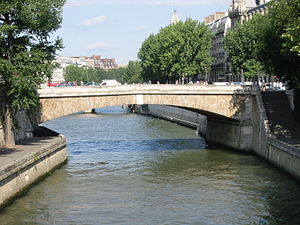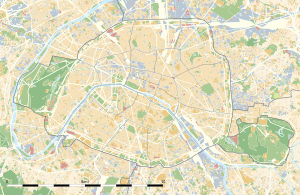Petit Pont Cardinal Funny
Coordinates: 48 ° 51 ′ 12 " N , 2 ° 20 ′ 49" E
| Petit Pont Cardinal Funny | ||
|---|---|---|
| Petit Pont from Pont au Double of view | ||
| Convicted | His | |
| Building number | 7295 | |
| construction | Arch bridge made of stone | |
| overall length | 32 m | |
| width | 20 m | |
| completion | 1853 | |
| planner |
Alexandre Michal Ernest Gariel |
|
| location | ||
|
|
||
The Petit Pont , also Petit-Pont , officially Petit-Pont-Cardinal-Lustiger in Paris since 2013, is a bridge over the Seine between the Île de la Cité and the left bank of the Seine .
The bridge crosses the river between the Pont au Double and the Pont Saint-Michel and connects the Rue de la Cité in the 4th arrondissement with the Rue du Petit Pont in the 5th arrondissement .
Characteristic
- Type: arch bridge
- Year of construction: 1853
- Architects: Michal and Gariel
- Material: stone
- Length: 32 m
- Width: 20 m
location
The bridge connects the Rue de la Cité and the Quai du Marché-Neuf (on the Île de la Cité ) with the Place du Petit-Pont on the Rive Gauche , between the Quai de Montebello and the Quai Saint-Michel , in extension of the Rue du Petit-Pont to Rue Saint-Jacques .
The Petit-Pont can be reached with the RER C , Saint-Michel - Notre-Dame station , Métrolinie 4 , Saint-Michel station or with the 24 and 47 buses .
Name origin
The name of the bridge comes from the fact that it crosses the small arm of the Seine , in contrast to the Grand Pont (later Pont au Change ) over the large arm of the Seine. It now also bears the name of Cardinal Jean-Marie Lustiger , Bishop of Paris from 1981 to 2005.
history
The Petit Pont has existed in this form since 1853, but is one of the two oldest bridges in the city. There was a bridge over the river on the site before the Romans conquered Gaul . When Titus Labienus met himself in 52 BC. When he approached the city with his troops, the Parisii destroyed these bridges in order to make it difficult for the enemy to cross the Seine and capture the city.
The Romans rebuilt the bridge in wood (in contrast to the bridge over the large arm of the Seine, for which they used stone) and made it a central part of their road from Soissons to Orléans , the Cardo of Lutetia , from which a few meters south also the roads to Burgundy and Lyon (see Rue Galande ) branched off.
In connection with the siege of Paris (885-886) the Petit Pont was destroyed. At the turn of the year, the Normans had interrupted active fighting due to weather conditions, but then resumed them at the end of January 886. They set three of their ships on fire and drifted them towards the wooden Petit Pont, thereby burning it down as well. However, the ships went down before they reached the bridge. What the Vikings failed to do was accomplished on February 6, 886 by heavy rains. The Seine burst its banks and tore away the wooden bridge, which was heavily used by hard fighting. The tower south of the bridge was now cut off from Paris and could be captured by the attackers.
After the end of the siege, the Petit Pont was rebuilt. In addition, the stone bridge of the Romans, which reached the right bank of the Seine within the Cardos from the Île de la Cité (today the Pont Notre-Dame ), was replaced by the wooden Pont du Roi or Grand Pont about 150 m downstream (today the Pont au Change ), so that until the 14th century Paris still had only two bridges, which were not even in a line. The two forts (the Grand Châtelet and the Petit Châtelet ), which now protected these bridges, lost their protective function when the city wall was built by King Philip Augustus .
The bridges over the Seine, including the Petit Pont, were heavily built-up (houses on bridges were the most hygienic) and thus economic centers of the city.
It was not until 1379 that Hugues Aubriot had the stone Pont Saint-Michel built a good 200 meters downstream, which relieved the Petit Pont. In 1393 the Petit Pont was destroyed by a tidal wave. In 1395 Raymond du Temple was commissioned to build a new building, but in 1408 it was also the victim of another flood, as was the new Pont Saint-Michel, which in fact divided the city into two parts. Both bridges were then rebuilt.
See also
Web links
- Website of the Mairie of Paris ( Memento of October 26, 2005 in the Internet Archive ) -
- Petit Pont Cardinal Funny. In: Structurae (French)
- Nomenclature of Parisian streets and bridges: Petit Pont ( Memento of March 27, 2007 in the Internet Archive )
Individual evidence
- ↑ Le Petit-Pont was renamed “Petit-Pont-Cardinal-Lustiger” by resolution (2013 DU 156) of the Conseil de Paris on June 11, 2013. See also: Petit-Pont-Cardinal-Lustiger at parisrues.com, accessed December 30, 2016

